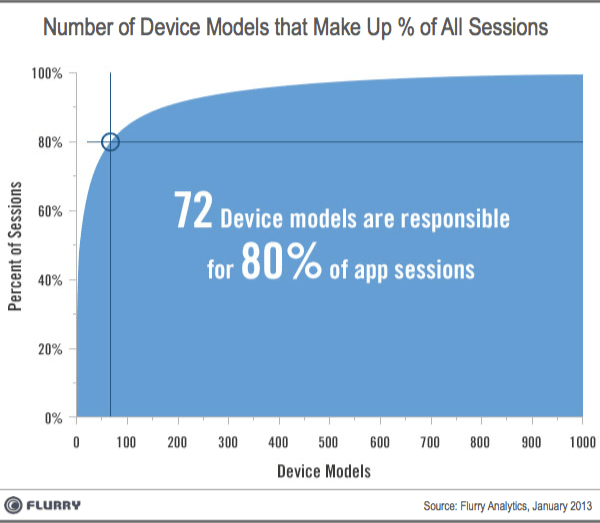With increasing number of devices comes increasing amount of fragmentation; different devices, different processors, different speeds, different GPUs, different screen size and what not! If the hardware trouble isn’t enough, developers have further trouble with different versions of OS on the devices. Flurry release a recent report which says that there are approximately 2130 mobile devices that use an app in the month of January alone! Imagine the plight of developers to make an app compatible with well, say at least most of the devices if not for all. Read on to know more about the scary truth behind app development for developers.

Number of devices
With the rapid rate at which various mobile devices are being produced in the market by various OEMs in a race to stay relevant in the market it is becoming impossible for developers to make their apps compatible with most devices. Flurry claims that there are more than 2200 different devices out there but using the 80/20 rule Flurry says that approximately 156 devices that drive almost 80% (no. of units) of total active devices out there.

To take it a bit further 37 devices make 60% and 18 devices make 50%. So if a developer is supposed to target at least 50% of active mobile devices out there then he has to test his app on at least 18 devices. And added to that, he has to test the apps for all most used versions of OS on all of those 18 devices!
The main difficulty for a developer arises to scale up the app for different screen sizes and still make it look usable, then the developer has to test it with different versions of the OS to ensure that the app does not use any incompatible APIs and the app runs smooth on all the devices. If on an average each of the devices 80% active users use has around 2 relevant and most used OS then the developer will have to test his app on 312 different combinations! Such complications are making things even more complicated for developers to invest money and time and make their app compatible, if the developers were to take a risk by releasing the app without much testing then there is every possibility that the app might crash driving more negative reviews to the developer thus making him obsolete and pushing him out of the system!
Usage time for OS/device
The only way ahead for developers to still stay relevant is to develop apps for OS/devices with high usage index (amount of time an app is used). Flurry reports that on an average iOS has 14 times more usage index than any other competing platforms.

If the same usage index is considered by manufacturer then Apple still leads by 7:1 compared to Android’s leading manufacturer Samsung. Whereas in tablet space Amazon has a better index again Apple at 7:1.7, nevertheless the usage index are still pretty poor for all other platforms apart from Apple.
Unless and until the usage index is high a developer does not make much revenue, especially if the app is a freemium or free app which earns most of its income from in-app purchases or ads.
App Session
App sessions is the number of sessions a device records for an app, say a user uses an app for 10 times a day then the app session of that app on that device is 10. App sessions are important because that gives an estimate of active users, who are the paying customers, that the developers need to target. App sessions seems to be better concentrated than the number of devices.

A developer has to make his app compatible with 82 devices to handle 80% app sessions and it declines to just 8 devices to cover devices responsible for 50% app sessions.
Future of small developers
So what does the once promising app stores hold for small and independent developers? A typical app will need an average team of 2 developers and 1 designer and considering the average paycheque of a US citizen which is approximately $50,000 an app should earn around $150,000 per year to ensure at least average pay for the team. That will convert to a sales figure of approximately 18 apps/hour for 24 hours a day and 365 days an year, anything less will mean that the developers will not even earn average pay.
Considering the humongous amount of time a team needs to invest to design, develop and test an app the returns are not very promising. Big corporates and companies have the resources to develop good apps and churn out good amounts of money but what about small developers? Well, even though things seem troublesome only time can answer this tricky question now.
Soruce: Flurry (A huge thanks to Flurry for such valuable information!)
